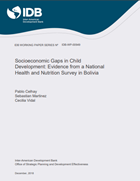Socioeconomic Gaps in Child Development: Evidence from a National Health and Nutrition Survey in Bolivia
Date
Dec 2018
This paper examines gaps in child development by socioeconomic status (SES) using a large nationally representative sample of children 0–59 months old in Bolivia and a rich set of child health and development outcomes including measures from dried blood samples. Child development is assessed with nutritional status, gross motor, and communicative development. Household SES is measured using direct and proxy indicators. We find an average difference of 0.80 and 0.60 standard deviations (SD) in height for age and weight for age z-scores respectively, between children in the top and bottom quintile of the expenditure distribution. Children in the top quintile are less likely to have iron deficiency (11 pp) and anemia (17 pp), whereas the gap in gross motor and communicative skills reach 0.28 and 0.20 SD respectively. By the age of three, these gaps have increased substantially to 0.92 SD (height for age), 0.24 pp (anemia), and 0.45 SD (gross motor). Our findings are robust to the choice of SES measurement and highlight the need to target social policies that can reduce these development gaps for children in low-income households.




